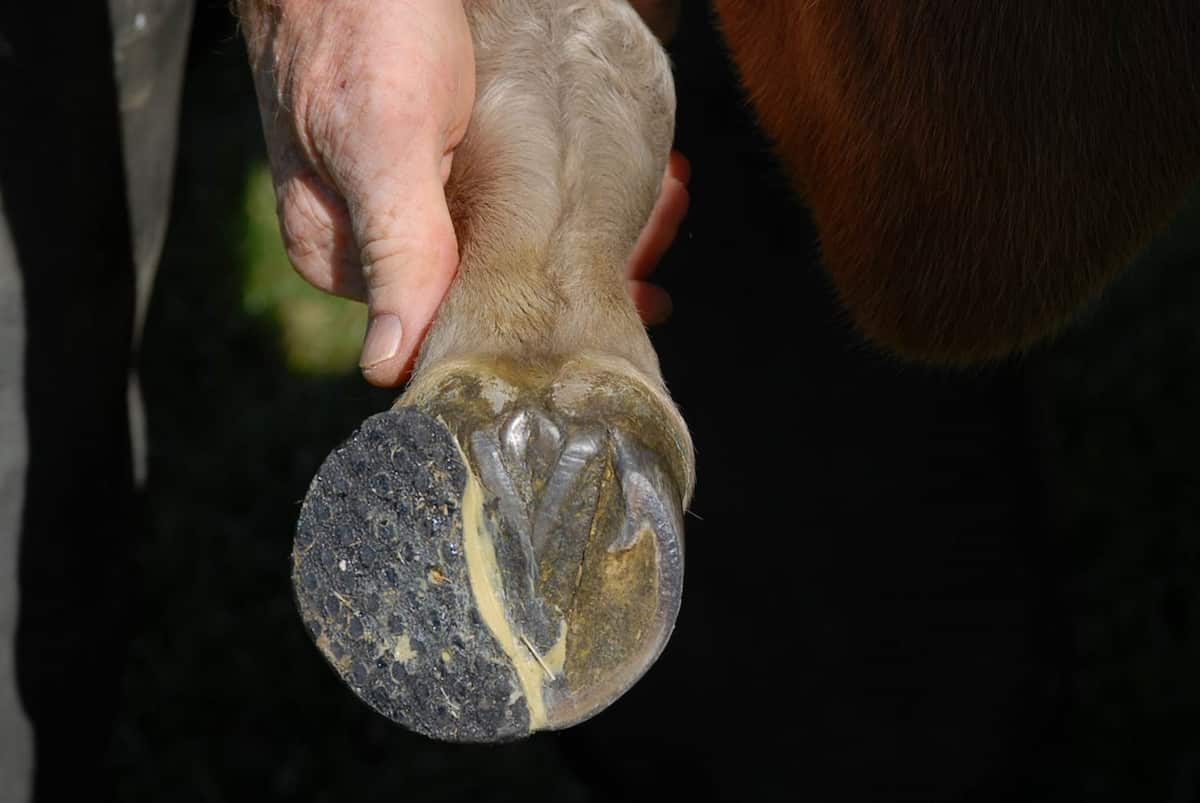Chances are, your OTTB was managed carefully to ensure he grew up with well-balanced limbs

Farriers can devise shoes with extensions to encourage the limbs to develop correctly. Courtesy Dr. Ric Redden/Nanric
Is anything cuter than a foal trying to stand for the first time? Those long, bendable things called legs sure don’t seem like they will hold him up.
But if all goes well, the foal will stand, and his legs will grow strong and straight, capable of carrying him into any athletic endeavor. Thoroughbred racehorse breeders match stallions and mares looking not only for speed but also good conformation that will help their foals become successful athletes.
Well-conformed Thoroughbreds typically sell for more money in the auction ring and stay sounder on the racetrack. That good conformation also aids them when they segue into a second career, whether it’s over jumps, around barrels or down trails.
Despite breeders’ best attempts, sometimes foals simply aren’t born with straight legs. And usually, in the first few days of life, minor limb deviations straighten naturally. But if they don’t, the people who raise these foals can help encourage growth in the right direction. A few management techniques can put a foal on the path to growing into a well-conformed athlete.
It Starts at Birth
Martha Jane Mulholland, owner of Mulholland Springs Farm, in Lexington, Kentucky, raises Thoroughbred racehorses and markets many of them at yearling sales. At the 2017 Keeneland September Yearling Sale, Mulholland sold several youngsters, including a son of Kentucky Derby winner Orb for $500,000.
Mulholland monitors the foals and their conformation from birth.
“I let them unfurl like a flag,” she says of a foal’s initial hours of life. “I’m hypervigilant with them — I look for any problems in the first 12 hours.”
Some foals arrive with what Mulholland calls a “windswept” look, where both fore or hind limbs slant in one direction. She says sometimes this occurs because the foal lay in an improper position in the womb during the last few weeks before birth.
“Most will right themselves,” she says, “but we may have to help some of them.”
If a foal doesn’t have conformational issues, Mulholland says it can soon be turned out to pasture with its dam. She turns her mares and foals out every day and brings them into stalls at night. That way she can look at the babies regularly and monitor conformation and other health needs.
Windswept foals or those with other problems might need to remain in a stall or small pen with their dams a little longer.
“Their bones are so soft, like butter, at that age,” says Mulholland. “Those bones (particularly hocks) can get crushed, and foals can get permanently injured. A lot of it is a matter of the tendons and the ligaments getting strong. Then the tendons and ligaments put the bones in place.”
Supporting Hooves & Limbs
Correcting conformation — perhaps better called encouraging the leg to grow properly — begins with the foot. Regular trimming of foals’ hooves can go a long way toward seeing that the rest of the limb grows straight and strong.
“We trim our foals initially at 10 days of age and then every two weeks,” Mulholland says. “If the angle of the growth plate in the ankle (fetlock) or the knee is not growing in a balanced fashion, we can support the ankle or the knee with how we trim the foot.”
The hope is this hoof care will encourage the joints to grow in that desired balanced fashion. If trimming alone doesn’t work, however, Mulholland’s farrier applies a hoof adhesive called Equilox to build up certain areas of the foot to encourage the ankles and knees to grow straight.
Glue-on shoes are another option. “We have lateral-support shoes that can also help when Equilox is not enough,” says Mulholland. “But you can’t leave them on for more than a couple of weeks or it will distort the very malleable hoof wall.”
Shoes can also help foals with issues such as weak pasterns, which result when the surrounding tendons are too lax at birth.
“Sometimes you’ll have a foal that is virtually walking on its pasterns and the hoof is up in the air,” says Mulholland.
With these foals she first applies bandages to support the pasterns. If that doesn’t work, she says she’s had success with trailer shoes, which have a cuff that cups the toe and an extension off the heels (see photo).
“It’s amazing how quickly those will help,” Mulholland says. “Because the trailer part makes the foot longer, the pivot point changes, bringing the foot up and changing the angle of the pasterns. If we use those shoes for a week or two and then remove them, the foal will often begin to (correct) on his own.”
In rare instances a veterinarian might recommend splints or surgery. Like trimming, the goal is to encourage growth in the proper direction.
“We use splints within the first few days of life for (foals that are) over at the knee (where it appears as if the knee is buckling forward),” says Mulholland.
Surgery usually involves inserting a screw across a growth plate of a joint, such as the ankle or knee, to encourage growth on one side and discourage it on the other so the joint grows properly.
As with any surgical procedure, foals generally require stall rest afterward. They can be moved gradually to larger areas, such as small outdoor pens, before they and their dams return to pasture with other mares and foals.
Feeding the Body
Good nutrition plays a huge role in helping foals mature with straight limbs and well-balanced joints. Overfeeding foals and weanlings can lead to epiphysitis, or inflammation of the growth plates.
“I think of a parallel as with young teenage boys whose shins hurt all the time, sometimes called growing pains,” says Mulholland. “Horses get that if they grow too fast. That will cause angular deformities as it heats up one side of the growth plate over the other and they aren’t allowed to grow in a balanced fashion.”
Mulholland notes the importance of weaning at the right time for each foal’s ideal development. She has found that most foals do best if weaned at about 5 months of age. But she might wean one earlier or later based on the mare’s milk supply.
“If you don’t wean a foal on time, they will get an awful lot of milk fat on them,” says Mulholland. “If these babies gain too much weight too fast, their bones can’t sustain it. Their legs will then tend to bow out.”
Nutrition and exercise play an even more important role after weaning. While the fetlock joint closes (the cartilage having matured to bone) at about 100 days, a horse’s knees continue to develop until he’s about 2 years old, and a horse doesn’t fully physically mature until he is 5.
A Balancing Act
Mulholland wants the horses she raises to grow into the soundest racehorses possible, with hopes it will complement their racing ability. The theory is the better conformed the horse, the fewer physical problems he’s likely to have. That, in turn, will keep him sounder for his second career, too.
“Raising a foal to be a sound racehorse is a matter of balance,” says Mulholland. “Balance how much you feed them. Balance how often you trim them. Balance when you wean them.”
The entire maturation process requires constant vigilance. “You can’t just turn them out and forget them,” says Mulholland. “We watch them like a hawk.”
This article was originally published in the Winter 2018 issue of Off-Track Thoroughbred Magazine, the only publication dedicated to the Thoroughbred ex-racehorse in second careers. Want four information-packed issues a year delivered to your door or your favorite digital device? Subscribe now!

